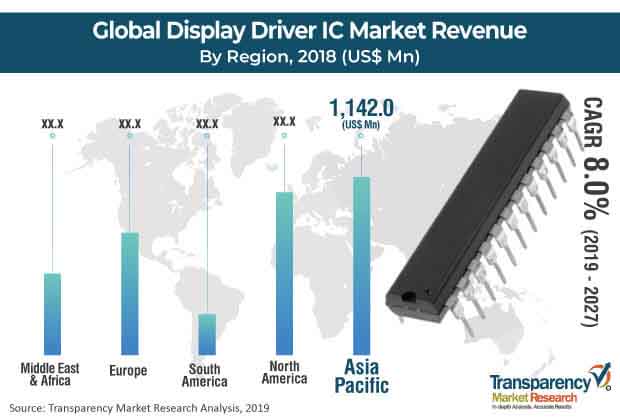
Global Display Driver IC Market – Snapshot
A display driver IC (DDIC) is used to operate display panels of hand-held devices such as mobile phones, wearable devices, laptops, and tablets. It receives digital data at a high speed (ranging from more than 500 Mbps to 1 Gbps) from the AP (application processor) and then converts it into analog voltage for operating the display panel. In electronics/computer hardware, a display driver is usually a semiconductor integrated circuit (IC) that provides an interface function between a microprocessor, microcontroller, ASIC (or general-purpose peripheral interface), and a particular type of display device such as LCD, LED, OLED, ePaper, or CRT. The global display driver IC market is projected to expand at a CAGR of 8.0% during the forecast period and reach value of US$ 6,842.2 Mn by 2027.

Free Customization as per your requirement, Buy Now
Significant sales of electronic devices, such as TVs, PCs, and mobile phones, are likely to significantly drive the global display driver IC market during the forecast period, as display driver ICs are used in the activation of pixels used in displays of TVs, PCs, and mobile phones. With the increasing use of smartphones across the globe, the demand for integration of touch and display controllers is likely to rise considerably in the next few years. This is expected to fuel the global display driver IC market between 2019 and 2027.
In order to meet this risen demand, several display manufacturers have started acquiring manufacturers of display driver ICs. Additionally, touchscreen displays are efficient in terms of time required to process an order and other on-demand functions, owing to automation. As the global automotive display industry continues to expand, the demand for high-quality display drivers is expected to increase during the forecast period. Also, application of LCD-based display driver products is likely to be further extended to a wide range of automotive applications such as instrument cluster, GPS navigation, and car entertainment displays in the near future. OLED display drivers are also anticipated to be widely adopted for use in automotive applications in the next few years.
Get More Press Releases by TMR: https://www.prnewswire.com/news-releases/long-term-health-hazards-loss-of-natural-habitat-of-terrestrial-aquatic-animals-due-to-rise-in-air-pollution-levels-drives-growth-in-air-quality-monitoring-equipment-market-valuation-projected-to-surpass-us-4-7-bn-by-2031–opi-301284496.html
Raw materials required in the production of display drivers, such as doped indium tin oxide (ITO), are scantily available, owing to their low occurrence in the Earth’s crust itself. Additionally, owing to increasing mining activities, availability of doped ITO has been decreasing further, while its prices are rising. Owing to low availability of raw materials, prices for the display driver technology are currently high. Furthermore, software and interface solutions embedded in touchscreen displays add to costs further, thereby increasing the total price of displays. These barriers are hindering the rate of adoption of display driver ICs across various industries.
To gauge the scope of customization in our reports, Ask for a Sample





